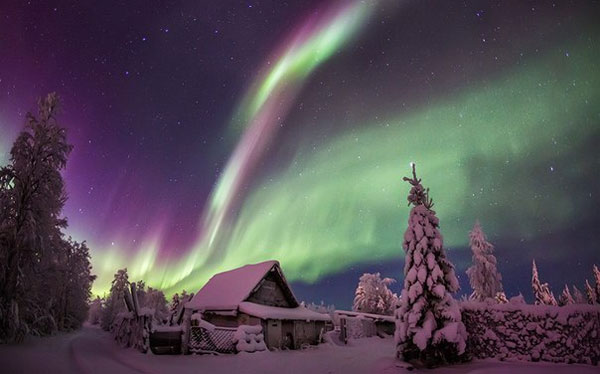Explanation of aurora phenomenon
The light of aurora is generated by the interaction between solar particles and the Earth's atmosphere.

Strip of light winding in the sky.(Photo: Twitter)
People living in high latitudes can witness aurora phenomenon, characterized by colorful light appearing in the night sky. In this phenomenon, bright bands continuously move and change. They are mostly green, sometimes with pink, red, purple and white.
The Sun lies about 150 million kilometers from Earth. Giant solar storms form a stream of energetic particles that fly in space. If the Earth is on the path of this particle stream, charged particles will "attack" the Earth's atmosphere.
The electrons in the atoms of the atmosphere will move up to orbits that carry higher energy, farther away from the atomic nucleus. When an electron moves back into orbit with a lower energy level, it releases a light particle or photon. According to scientists, the process of aurora phenomenon is similar to what happens in neon bulbs, but is much larger.
The aurora appears in an arc or spiral, following the Earth's magnetic field. Researchers say that different gases in the Earth's atmosphere create a brilliant color of aurora. For example, oxygen forms green, nitrogen forms blue or red.
- Aurora is on Christmas
- Bright light of aurora
- Beautiful aurora covers the famous Mackinac Bridge
- Beautiful aurora in the Lewis Island area
- Hi Steve, a beautiful new aurora phenomenon has just been discovered!
- Virtual aurora phenomenon in Russia
- See the virtual aurora on the earth from the universe
- Eyjafjallajokull's wrath faded under the aurora
- Rare aurora phenomenon occurs in the US
- Mysterious purple aurora on Mars
- See the beautiful north aurora from the biggest solar storm
- Moon rainbow and aurora together appear in Sweden
 Van Allen's belt and evidence that the Apollo 11 mission to the Moon was myth
Van Allen's belt and evidence that the Apollo 11 mission to the Moon was myth The levels of civilization in the universe (Kardashev scale)
The levels of civilization in the universe (Kardashev scale) Today Mars, the sun and the Earth are aligned
Today Mars, the sun and the Earth are aligned The Amazon owner announced a secret plan to build a space base for thousands of people
The Amazon owner announced a secret plan to build a space base for thousands of people What would happen if you dug a hole through the Earth and jumped in?
What would happen if you dug a hole through the Earth and jumped in?  Chilling discovery of cosmic object that almost brought the Earth to 'apocalypse'
Chilling discovery of cosmic object that almost brought the Earth to 'apocalypse'  The Sun goes into hibernation, will the Earth usher in a new ice age?
The Sun goes into hibernation, will the Earth usher in a new ice age?  Discovery of space object powerful enough to tear apart the Earth
Discovery of space object powerful enough to tear apart the Earth  NASA to test 'pneumatic brakes' for Mars lander
NASA to test 'pneumatic brakes' for Mars lander  Breakthrough discovery of planet with more water than Earth
Breakthrough discovery of planet with more water than Earth 